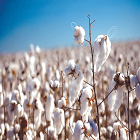"Cotton production in the United States is touted to recover in 2016/17. While consumption remains stable cotton planting in Northern Hemisphere countries commences this month. In 2016/17, world cotton area is expected to expand by 1 per cent to 31.3 million hectares. From December 2015 through February 2016, international cotton prices as measured by the Cotlook A Index averaged 69 cents"

Cotton production in the United States is touted to recover in 2016/17. While consumption remains stable cotton planting in Northern Hemisphere countries commences this month. In 2016/17, world cotton area is expected to expand by 1 per cent to 31.3 million hectares. From December 2015 through February 2016, international cotton prices as measured by the Cotlook A Index averaged 69 cents/lb.
Cotton an attractive proposition
However, prices for competing crops during the same period have fallen, making cotton more competitive this year compared to last. World cotton production in 2016/17 is projected to increase by 4 per cent to just under 23 million tons, as the world average yield is anticipated to improve by 4 per cent to 732 kg/ha. In 2016/17, India’s area is forecast up 4 per cent to 12.4 million hectares due to improved domestic cotton prices in 2015/16. Assuming yield is similar

Assuming yield is similar to the 4-year average of 522 kg/ha, production could reach 6.5 million tons in 2016/17. In March, the Chinese government announced a reduced target price for Xinjiang of 18600 yuan/ton.
As a result, area is likely to contract by 10 per cent to 3.1 million hectares and production to decrease to 4.6 million tons. Cotton area in the United States is projected to increase by 2 per cent to 3.3 million hectares and production by 9 per cent to 3.1 million tons. After production plummeted in 2015/16, cotton production in Pakistan is expected to jump 35 per cent to 2.1 million tons as yields recover.
After declining by 2 per cent in 2015/16, world cotton consumption is anticipated to remain stable at 23.9 million tons. Consumption in China is projected to decrease by 5 per cent to 6.8 million tons due to increasing wages, high domestic cotton prices, and low polyester prices. In 2016/17,
Vietnam’s cotton consumption is forecast to rise 16 per cent to 1.3 million tons, making it the fifth largest consumer. Consumption in Bangladesh, the sixth largest, could increase by 10 per cent to 1.2 million tons. After several seasons of growth, cotton mill use in India and Pakistan contracted in 2015/16 due to weaker demand. However, India’s consumption is projected to rise by 4 per cent to 5.5 million tons, and in Pakistan by 1 per cent to 2.2 million tons. After declining by 3 per cent in 2015/16, world cotton trade is expected to recover by 1per cent to 7.5 million tons in 2016/17, as consumption grows in import dependent countries. Vietnam and Bangladesh are likely to be
The two largest importers of cotton in 2016/17, with import volumes expected to rise by 25 per cent to 1.4 million tons and by 5 per cent to 1.1 million tons, respectively. China could see imports fall by 13 per cent to 936,000 tons. Exports from the United States are projected to increase by 1 per cent to 2.2 million tons while exports from India are forecast to decline by 13% to 1 million tons.












